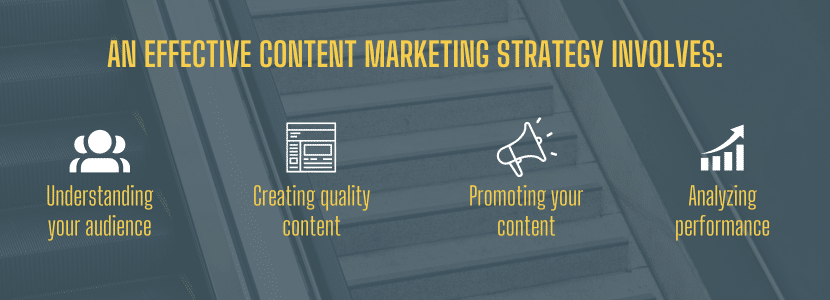Think about the last purchase you made. Why did you choose that particular business over the competition?
To stand out from the competition is to have a great product or service combined with branding, customer relationships, great customer service, trust, and loyalty.
In today’s online world, it can be difficult to differentiate your business from the rest of the pack.
Competition is everywhere.
But how to stand out from competitors in such a crowded field?
In this guide, you will discover the keys to making your business stand out from the competition!
With the right strategy, you can differentiate yourself, learn how to make your business stand out from the rest, and achieve success. Let’s dive in!
Identify your Value Differentiators — what makes you stand out from the competition?
Your value differentiators is the cornerstone of your business strategy. It is your competitive advantage and, notably, it’s what sets your business apart from the rest, attracting new customers to your brand.
Your value differentiators should help answer crucial questions like:
“Why should I choose you over your competitors?”
“What makes you different from your competitors?”
Businesses stand out by clearly communicating their value differentiators, which often acts as a differentiating factor that customers notice. Let’s look at some scenarios to shed light on what makes your business unique.
Imagine you are a local construction contractor.
Your value differentiator could be that you offer a quality service at competitive prices and provide personalized customer service. By tailoring your services to the needs of each customer, you gain an edge over competitors who simply offer a generic solution.
Or perhaps you’re a software development company whose value differentiator lies in the superior user experience and post-sale technical support you provide, something your competitors fail to match. This is how to make your business stand out.
These “what makes your business special examples” are extensive. They underline the diversity of value differentiators across different sectors.
Your value differentiator is not only what makes your company different from your competitors. It should be easily understood. It should resonate with your target market. Indeed, it encapsulates examples of what you offer that your competitors do not and why your solution is the best choice.
Understanding and effectively communicating your value differentiator can elevate your credibility, attract potential customers, enhance customer experience and loyalty, and ultimately, propel business growth.
There are various aspects to consider when identifying your value differentiator, such as :
Uniqueness
What do you offer that no one else does? What makes your company different from your competitors? This could be anything from a unique product or service to an innovative approach to solving a problem.
The best way to stand out from the competition is to identify and emphasize you are truly one of a kind. Maybe the “what makes your business unique examples” are already part of your branding, or perhaps you need to brainstorm some with the help of a branding agency.
Relevance
Does your offering align with the needs and wants of your target market? You need to understand your audience and ensure that your value differentiator addresses their specific needs or problems.
Value
Does your product or service provide value and make life easier for your customers? This could mean offering high-quality products, providing excellent customer service, or offering competitive pricing.
In the quest of how to make your product stand out from competitors, your value differentiator takes center stage. It underlines the unique benefits that your product brings and provides a compelling reason for customers to choose your product over others.
Communication
The next step in how to make your company stand out is effectively communicating your value differentiator through your website, marketing channels, social media, and other customer touchpoints.
Ensure your value differentiator is consistently present across all platforms to ensure your message resonates with your audience. You can also have a “what sets your business apart from your competitors examples” section, such as:
- your service is organic in a sea of non-organic choices.
- you’re open early and late, when competitors are not.
- you provide several levels/pricing of post-sale service packages.
First, though, you have to identify the “how does your business stand out examples.” Then, make sure the message is clear and concise.
Ultimately, the question of how to make your business stand out and how to be different in business is rooted in your value differentiator. It is what makes your business special, and indeed, it’s what will give you a competitive edge.
So take the time to identify your value differentiator, and then let the world know about it.
Invest in a user-friendly website that reflects your brand and mission
In today’s digital age, a website is not a luxury but a necessity for businesses, especially small businesses. According to statistics, 91% of customers have visited a store after interacting with a website, and 81% of consumers research products or services online before purchasing.

Your website is your virtual storefront, open 24/7, and accessible from anywhere in the world. But having a website is not enough. It must be user-friendly, reflecting your brand and mission, and providing a seamless customer journey.
A user-friendly website is easy to navigate, has a clear and simple design, and loads quickly. These characteristics are crucial in providing a positive user experience, which can increase customer satisfaction and loyalty.
Investing in a user-friendly website involves:
Design
The design of your website should be visually appealing, clean, and consistent with your brand identity. It should also be easy to navigate, with clear menus and links to key pages.
Content
Your website content should be relevant, informative, and engaging. It should reflect your brand’s voice and message and provide value to your visitors. Content also serves another important purpose: with it, you can explain what makes your business stand out, and what makes your company different from your competitors’ examples.
Performance
Your website should load quickly and function correctly on all devices and browsers. Slow load times or technical issues can deter visitors and negatively impact your search engine ranking.
SEO
Search Engine Optimization (SEO) is the process of optimizing your website for the search engine, so it can be easily found by potential customers.
Implementing SEO strategies and best practices can increase your website’s visibility on search engine result pages, leading to increased traffic and potential sales.
Utilize data to track performance and make informed decisions about investments
Data is a powerful tool in business decision-making. It provides valuable insights into your business performance, customer behavior, and market trends. Leveraging data allows you to make informed decisions, improve efficiency, and drive business growth.
Data can be gathered from various sources, including your website analytics, customer feedback, social media, and sales data. Once collected, this data should be analyzed to derive meaningful insights.
For example, website analytics can provide insights into your website’s performance, such as the number of visitors, bounce rate, and conversion rate. This data can help you identify areas of improvement, inform your marketing strategies, and enhance the user experience. Any successful business needs to understand its market and customers, and data is the key to making informed decisions.
Customer feedback, on the other hand, can provide insights into customer satisfaction, preferences, and buying behavior for many businesses. This data can inform product development, good customer service improvements, and marketing messages.
Similarly, sales data can provide insights into your sales performance, identifying trends, and highlighting growth opportunities. This data can inform investment decisions, pricing strategies, and sales forecasts.
Develop an effective content marketing strategy to engage customers with relevant content
Content marketing is an effective strategy to engage customers, build brand awareness, and drive sales.
It involves creating and sharing valuable content that is relevant to your target audience. This content can take various forms, including blog posts, videos, infographics, social media posts, and ebooks.

An effective content marketing strategy involves the following:
Understanding your audience
Before creating content, you need to understand your target audience. What are their needs and interests? What type of content do they consume, and where do they consume it?
Creating quality content
Your content should provide value to your audience. This could be by informing, entertaining, or inspiring them. Quality content is not only more likely to engage your audience but also to be shared, increasing your reach. Include Share links to make it easy for your audience to share your content with their contacts.
Promoting your content
Simply creating content is not enough. You need to promote it to reach your target audience. This could be through social media, email marketing, SEO, or paid advertising.
Analyzing performance
Once your content is live, it’s crucial to track its performance. This can provide insights into what type of content resonates with your audience and inform future content creation.
Test different ad campaigns to learn which are the most successful and cost-effective
Advertising is a significant part of many small businesses’ marketing strategies. However, not all ad campaigns are created equal. It’s essential to regularly evaluate your campaigns to ensure they are successful and cost-effective.
Evaluating ad campaigns involves analyzing key metrics such as reach, impressions, clicks, conversions, and return on investment (ROI). These metrics can provide insights into how well your ads are performing and whether they are delivering an ROI.
For example, reach and impressions can indicate how many people saw your ad, while clicks can show how many people engaged with it. Conversions, on the other hand, can show how many people took the desired action after seeing your ad, such as making a purchase or filling out a form.
By analyzing these metrics, you can identify which ads are most effective and where to allocate your advertising budget. You can also identify areas for improvement and adjust your campaigns accordingly.
Matched audience campaigns are also extremely effective for B2B businesses. Matched audience campaigns ensure that only your target prospects can see your ads. A matched audience campaign targets prospects by combining your business data with available professional data. To run a matched audience campaign on LinkedIn, for example, all you need to do is upload your LinkedIn leads (that is, the list of prospects you’d like to advertise to) to the app. Then, LinkedIn matches the contact information you upload to profiles within the app.
Utilize customer reviews and feedback to develop new products/services tailored to customer needs
Customer feedback is a valuable resource in business. It provides insights into customer satisfaction, preferences, and needs. This information can guide the development of new products or services, helping to ensure they meet customer expectations while providing the best customer service possible and fulfilling a need in the market.
Collecting customer feedback can be done in various ways, such as surveys, reviews, social media comments, and direct communication.
Once collected, this feedback should be analyzed to identify common themes and areas for improvement. Negative feedback online indicates areas to address, while positive feedback can provide ideas for new products or services.
For example, if multiple customers mention a particular issue with a product, it could indicate a need for improvement or the development of a new product.
Similarly, if customers express a need or desire that is not currently met by your products or services, it could indicate a market gap that your business could fill.
Using customer feedback to inform product development improves customer satisfaction and also increases the likelihood of product success. After all, you’re creating products or services you know your customers want or need.
Discover what makes your company different from your competitors with Take the Stairs!
Standing out in a competitive business landscape involves a multitude of factors. From identifying your value differentiators to utilizing customer feedback and business news for product development, each step is crucial for achieving success.
However, undertaking this journey might feel overwhelming. What makes your business stand out best answers the question, “How is my company different?”
That’s where we come in. Our team at “Take the Stairs”, a Nashville-based marketing agency, is dedicated to helping small businesses navigate these steps.
We offer a comprehensive suite of services designed to help you pinpoint what sets you apart, optimize your online presence, make data-driven decisions, devise effective content strategies, develop advertising campaigns, and utilize valuable customer feedback.
With our assistance, you can carve out a unique space in the market and foster a thriving business.
Don’t get lost in the crowd. Discover what makes your company different, leverage it to your advantage, and climb to new heights.
Contact us today, and embark on a journey to outshine your competitors!












